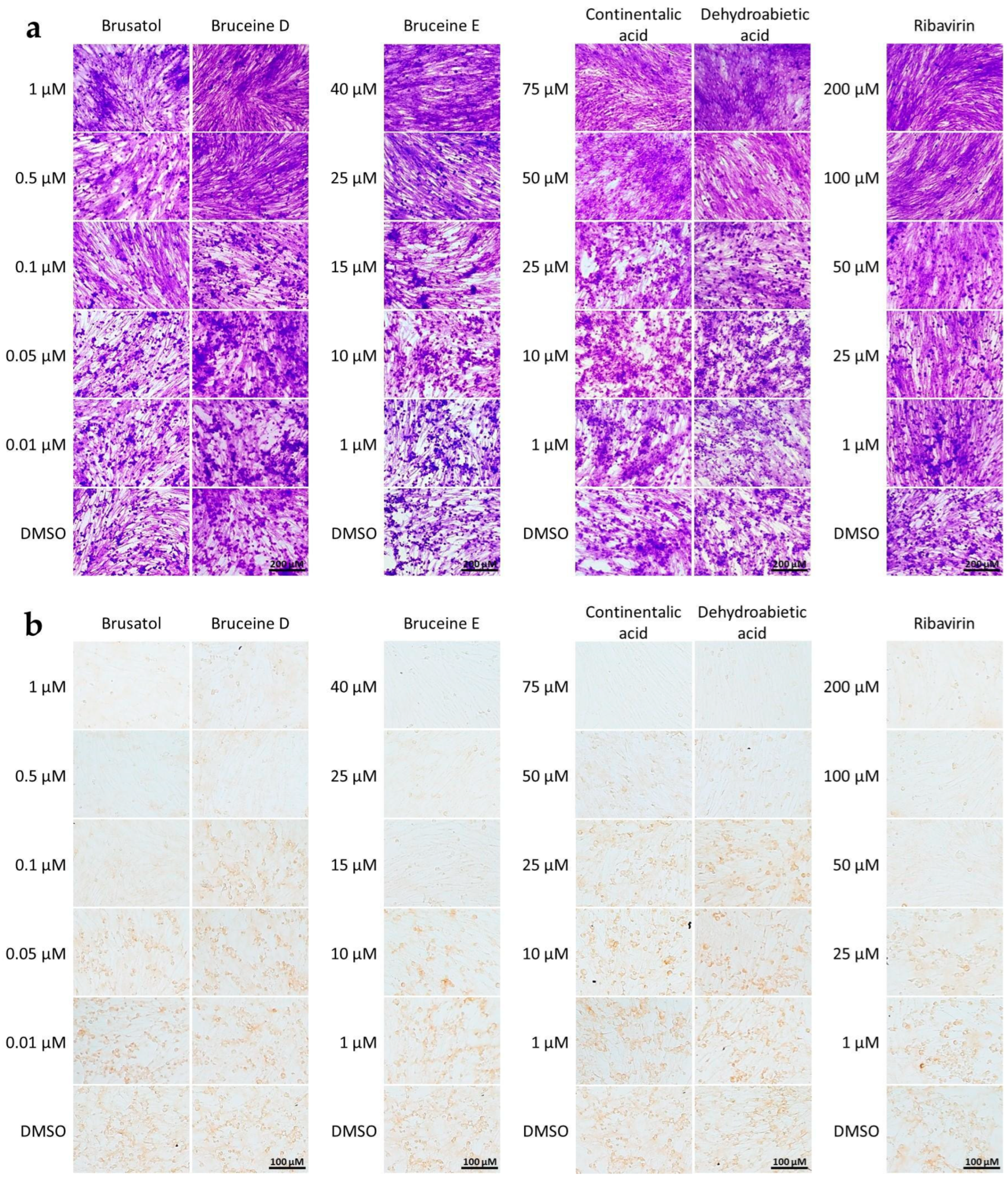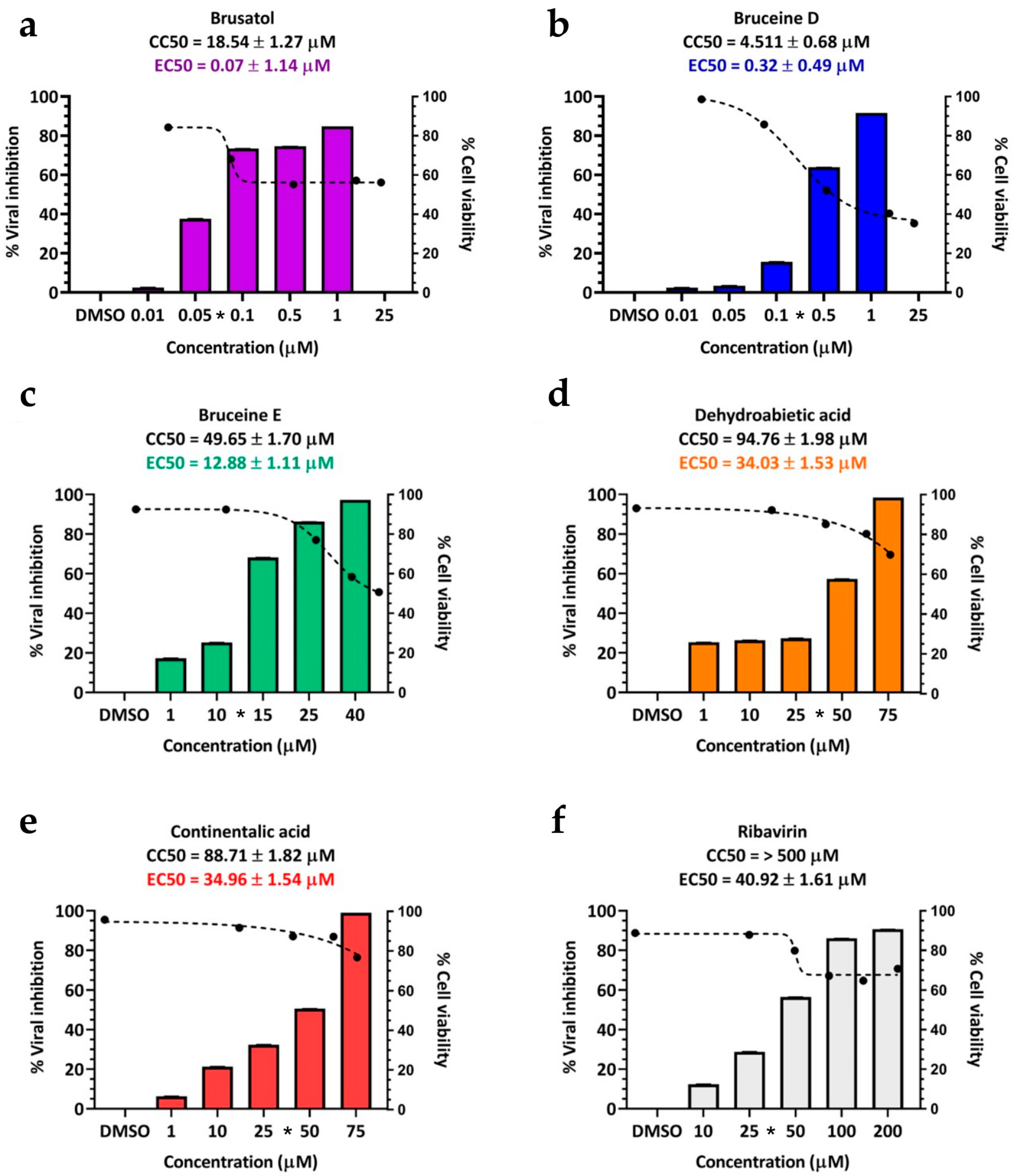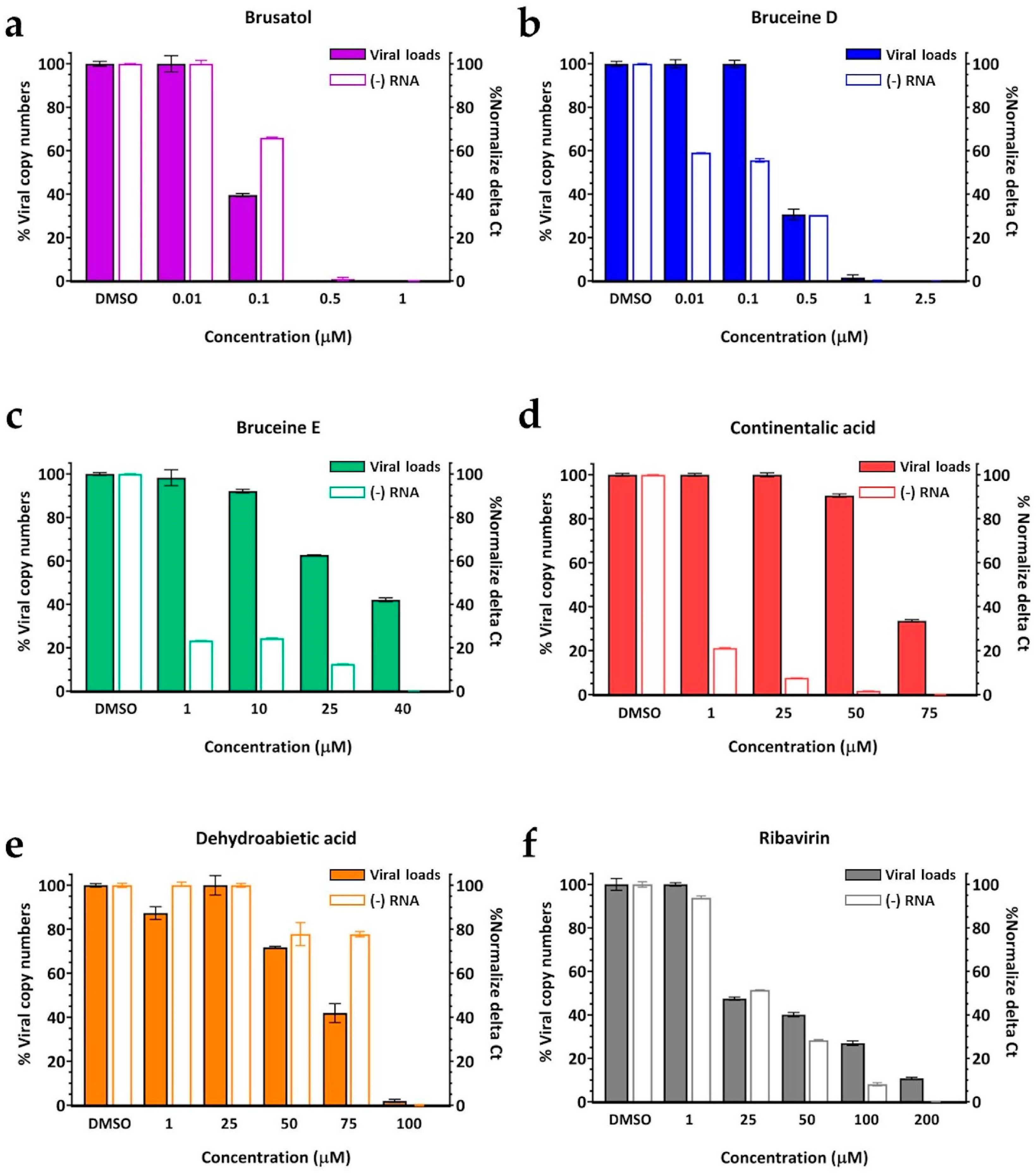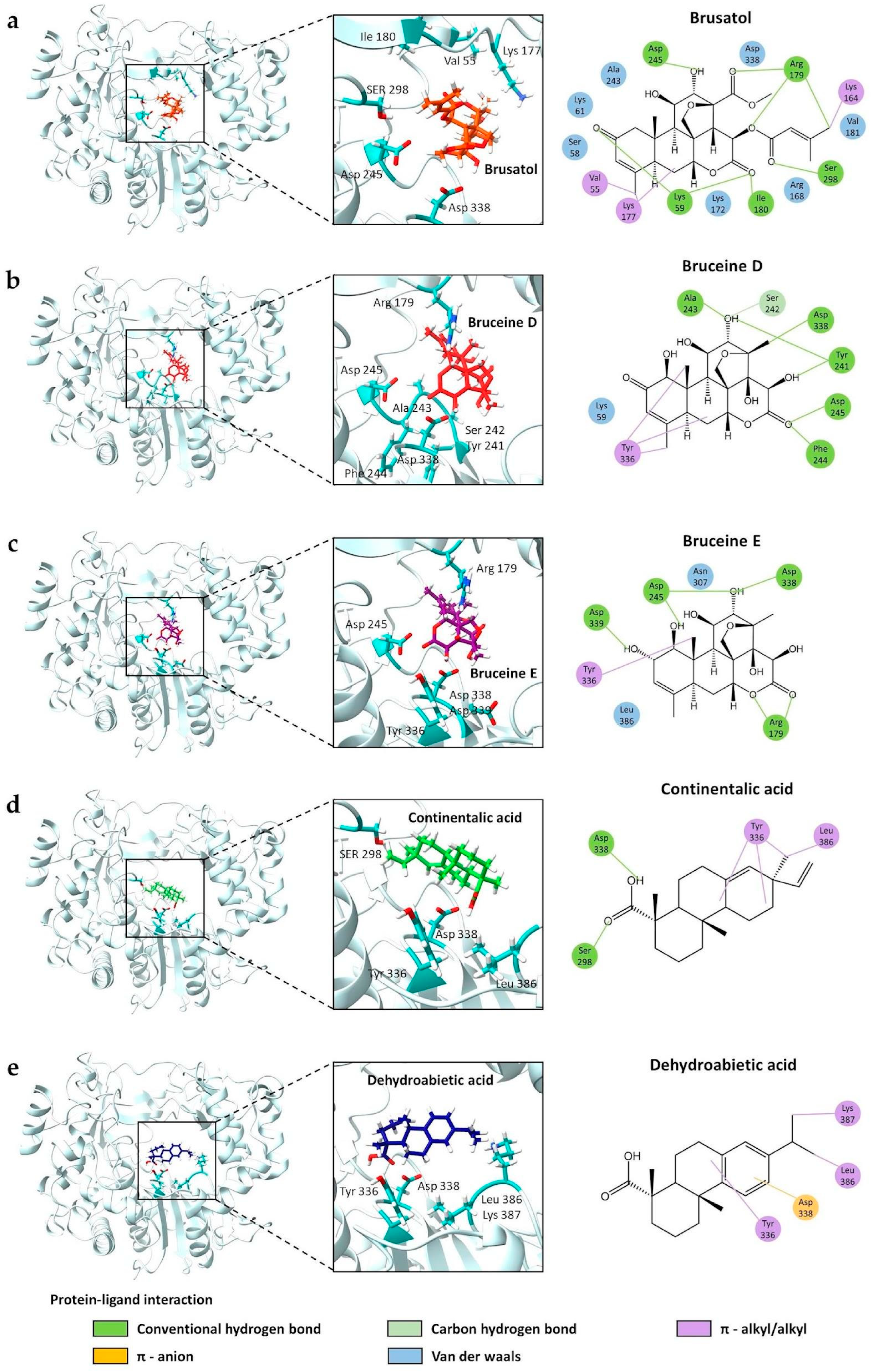Naturally Derived Terpenoids Targeting the 3Dpol of Foot-and-Mouth Disease Virus: An Integrated In Silico and In Vitro Investigation
Abstract
:1. Introduction
2. Materials and Methods
2.1. Virtual Screening
2.1.1. Preparation of FMDV 3Dpol and Terpenoids
2.1.2. Molecular Docking and Protein–Ligand Interaction
2.2. Cells, Virus, and Compounds
2.2.1. Cells and Viruses
2.2.2. Terpenoid Compounds
2.3. Cytotoxicity Assay
2.4. Antiviral Activity
2.5. Cytopathic Effect (CPE) Inhibition Assay
2.6. Immunoperoxidase Monolayer Assay (IPMA)
2.7. Reverse Transcription-Quantitative Polymerase Chain Reaction (RT-qPCR)
2.8. Determination of Anti-FMDV 3Dpol Activity Using an FMDV Minigenome Assay
2.9. Antiviral Combination Assay of Potential Terpenoids
3. Results
3.1. Virtual Screening of Terpenoid Compounds
3.2. Cytotoxicity Assay to BHK-21 Cells
3.3. Antiviral Activity of Terpenoids
3.4. Viral Load Quantification Using RT-qPCR
3.5. Inhibition of FMDV 3Dpol Using an FMDV Minigenome Assay
3.6. Protein–Ligand Interaction
3.7. Brusatol and Bruceine D Enhance the Antiviral Activity of Ribavirin
4. Discussion
5. Conclusions
Supplementary Materials
Author Contributions
Funding
Institutional Review Board Statement
Informed Consent Statement
Data Availability Statement
Acknowledgments
Conflicts of Interest
References
- Davies, G. Foot and mouth disease. Res. Vet. Sci. 2002, 73, 195–199. [Google Scholar] [CrossRef] [PubMed]
- Grubman, M.J.; Baxt, B. Foot-and-mouth disease. Clin. Microbiol. Rev. 2004, 17, 465–493. [Google Scholar] [CrossRef] [PubMed]
- Belsham, G.J. Towards improvements in foot-and-mouth disease vaccine performance. Acta Vet. Scand. 2020, 62, 20. [Google Scholar] [CrossRef] [PubMed]
- Carrillo, C.; Tulman, E.R.; Delhon, G.; Lu, Z.; Carreno, A.; Vagnozzi, A.; Kutish, G.F.; Rock, D.L. Comparative genomics of foot-and-mouth disease virus. J. Virol. 2005, 79, 6487–6504. [Google Scholar] [CrossRef] [PubMed]
- Beigel, J.H.; Tomashek, K.M.; Dodd, L.E.; Mehta, A.K.; Zingman, B.S.; Kalil, A.C.; Hohmann, E.; Chu, H.Y.; Luetkemeyer, A.; Kline, S.; et al. Remdesivir for the treatment of COVID-19—Final report. N. Engl. J. Med. 2020, 383, 1813–1826. [Google Scholar] [CrossRef] [PubMed]
- Peng, S.; Wang, H.; Wang, Z.; Wang, Q. Progression of antiviral agents targeting viral polymerases. Molecules 2022, 27, 7370. [Google Scholar] [CrossRef] [PubMed]
- Wardana, A.P.; Aminah, N.S.; Rosyda, M.; Abdjan, M.I.; Kristanti, A.N.; Tun, K.N.W.; Choudhary, M.I.; Takaya, Y. Potential of diterpene compounds as antivirals, a review. Heliyon 2021, 7, e07777. [Google Scholar] [CrossRef] [PubMed]
- Ludwiczuk, A.; Skalicka-Woźniak, K.; Georgiev, M.I. Terpenoids. In Pharmacognosy; Badal, S., Delgoda, R.B.T.P., Eds.; Elsevier: Boston, MA, USA, 2017; pp. 233–266. ISBN 978-0-12-802104-0. [Google Scholar] [CrossRef]
- Proshkina, E.; Plyusnin, S.; Babak, T.; Lashmanova, E.; Maganova, F.; Koval, L.; Platonova, E.; Shaposhnikov, M.; Moskalev, A. Terpenoids as potential geroprotectors. Antioxidants 2020, 9, 529. [Google Scholar] [CrossRef] [PubMed]
- Semkum, P.; Kaewborisuth, C.; Thangthamniyom, N.; Theerawatanasirikul, S.; Lekcharoensuk, C.; Hansoongnern, P.; Ramasoota, P.; Lekcharoensuk, P. A novel plasmid DNA-based foot and mouth disease virus minigenome for intracytoplasmic mRNA production. Viruses 2021, 13, 1047. [Google Scholar] [CrossRef]
- Semkum, P.; Thangthamniyom, N.; Chankeeree, P.; Keawborisuth, C.; Theerawatanasirikul, S.; Lekcharoensuk, P. The application of the Gibson assembly method in the production of two pKLS3 vector-derived infectious clones of foot-and-mouth disease virus. Vaccines 2023, 11, 1111. [Google Scholar] [CrossRef]
- Valdes-Jimenez, A.; Pena-Varas, C.; Borrego-Munoz, P.; Arrue, L.; Alegria-Arcos, M.; Nour-Eldin, H.; Dreyer, I.; Nunez-Vivanco, G.; Ramirez, D. PSC-db: A structured and searchable 3D-database for plant secondary compounds. Molecules 2021, 26, 1124. [Google Scholar] [CrossRef] [PubMed]
- Lipinski, C.A. Lead-and drug-like compounds: The rule-of-five revolution. Drug Discov. Today Technol. 2004, 1, 337–341. [Google Scholar] [CrossRef] [PubMed]
- Dallakyan, S.; Olson, A.J. Small-molecule library screening by docking with PyRx. In Chemical Biology: Methods and Protocols, Methods in Molecular Biology; Hempel, J.E., Williams, C.H., Hong, C.C., Eds.; Springer: New York, NY, USA, 2015; Volume 1263, pp. 243–250. [Google Scholar] [CrossRef]
- Trott, O.; Olson, A.J. AutoDock Vina: Improving the speed and accuracy of docking with a new scoring function, efficient optimization, and multithreading. J. Comput. Chem. 2010, 31, 455–461. [Google Scholar] [CrossRef] [PubMed]
- Theerawatanasirikul, S.; Semkum, P.; Lueangaramkul, V.; Chankeeree, P.; Thangthamniyom, N.; Lekcharoensuk, P. Non-nucleoside inhibitors decrease foot-and-mouth disease virus replication by blocking the viral 3Dpol. Viruses 2022, 15, 124. [Google Scholar] [CrossRef] [PubMed]
- Lekcharoensuk, P.; Wiriyarat, W.; Petcharat, N.; Lekcharoensuk, C.; Auewarakul, P.; Richt, J.A. Cloned cDNA of A/swine/Iowa/15/1930 internal genes as a candidate backbone for reverse genetics vaccine against influenza A viruses. Vaccine 2012, 30, 1453–1459. [Google Scholar] [CrossRef]
- Reed, L.J.; Muench, H. A simple method of estimating fifty percent endpoints. Am. J. Epidemiol. 1938, 27, 493–497. [Google Scholar] [CrossRef]
- Lekcharoensuk, P.; Nanakorn, J.; Wajjwalku, W.; Webby, R.; Chumsing, W. First whole genome characterization of swine influenza virus subtype H3N2 in Thailand. Vet. Microbiol. 2010, 145, 230–244. [Google Scholar] [CrossRef]
- Sariya, L.; Thangthumniyom, N.; Wajjwalku, W.; Chumsing, W.; Ramasoota, P.; Lekcharoensuk, P. Expression of foot and mouth disease virus nonstructural polyprotein 3ABC with inactive 3Cpro in Escherichia coli. Protein Expr. Purif. 2011, 80, 17–21. [Google Scholar] [CrossRef]
- Theerawatanasirikul, S.; Lueangaramkul, V.; Semkum, P.; Lekcharoensuk, P. Antiviral mechanisms of sorafenib against foot-and-mouth disease virus via c-RAF and AKT/PI3K pathways. Vet. Res. Commun. 2024, 48, 329–343. [Google Scholar] [CrossRef]
- Ianevski, A.; Giri, A.K.; Aittokallio, T. SynergyFinder 3.0: An interactive analysis and consensus interpretation of multi-drug synergies across multiple samples. Nucleic Acids Res. 2022, 50, W739–W743. [Google Scholar] [CrossRef]
- Ferrer-Orta, C.; Arias, A.; Perez-Luque, R.; Escarmís, C.; Domingo, E.; Verdaguer, N. Structure of Foot-and-Mouth Disease Virus RNA-dependent RNA Polymerase and Its Complex with a Template-Primer RNA. J. Biol. Chem. 2004, 279, 47212–47221. [Google Scholar] [CrossRef] [PubMed]
- Ganesan, A. The impact of natural products upon modern drug discovery. Curr. Opin. Chem. Biol. 2008, 12, 306–317. [Google Scholar] [CrossRef]
- Lipinski, C.A. Rule of five in 2015 and beyond: Target and ligand structural limitations, ligand chemistry structure and drug discovery project decisions. Adv. Drug Deliv. Rev. 2016, 101, 34–41. [Google Scholar] [CrossRef] [PubMed]
- Yu, X.; Shang, X.; Huang, X.; Yao, G.; Song, S. Brusatol: A potential anti-tumor quassinoid from Brucea javanica. Chin. Herb. Med. 2020, 12, 359–366. [Google Scholar] [CrossRef] [PubMed]
- Zhang, J.; Xu, H.-X.; Dou, Y.-X.; Huang, Q.-H.; Xian, Y.-F.; Lin, Z.-X. Major constituents from Brucea javanica and their pharmacological actions. Front. Pharmacol. 2022, 13, 853119. [Google Scholar] [CrossRef] [PubMed]
- Murakami, Y.; Sugiyama, K.; Ebinuma, H.; Nakamoto, N.; Ojiro, K.; Chu, P.; Taniki, N.; Saito, Y.; Teratani, T.; Koda, Y.; et al. Dual effects of the Nrf2 inhibitor for inhibition of hepatitis C virus and hepatic cancer cells. BMC Cancer 2018, 18, 680. [Google Scholar] [CrossRef]
- Ye, R.; Dai, N.; He, Q.; Guo, P.; Xiang, Y.; Zhang, Q.; Hong, Z.; Zhang, Q. Comprehensive anti-tumor effect of Brusatol through inhibition of cell viability and promotion of apoptosis caused by autophagy via the PI3K/Akt/MTOR pathway in hepatocellular carcinoma. Biomed. Pharmacother. 2018, 105, 962–973. [Google Scholar] [CrossRef]
- Yan, X.-H.; Chen, J.; Di, Y.-T.; Fang, X.; Dong, J.-H.; Sang, P.; Wang, Y.-H.; He, H.-P.; Zhang, Z.-K.; Hao, X.-J. Anti-tobacco mosaic virus (TMV) quassinoids from Brucea javanica (L.) Merr. J. Agric. Food Chem. 2010, 58, 1572–1577. [Google Scholar] [CrossRef]
- Shen, J.; Zhang, Z.; Wu, Z.; Ouyang, M.; Xie, L.; Lin, Q. Antiphytoviral activity of bruceine-D from Brucea javanica seeds. Pest. Manag. Sci. 2008, 64, 191–196. [Google Scholar] [CrossRef]
- Zhang, J.-W.; Wang, H.; Liu, J.; Ma, L.; Hua, R.-H.; Bu, Z.-G. Generation of a stable GFP-reporter Zika virus system for high-throughput screening of Zika virus inhibitors. Virol. Sin. 2021, 36, 476–489. [Google Scholar] [CrossRef]
- He, X.; Zheng, Y.; Tian, C.; Wen, T.; Yang, T.; Yu, J.; Fang, X.; Fan, C.; Liu, J.; Yu, L. Quassinoids from Eurycoma longifolia with antiviral activities by inhibiting dengue virus replication. Phytomedicine 2023, 110, 154650. [Google Scholar] [CrossRef] [PubMed]
- Li, Z.; Ruan, J.; Sun, F.; Yan, J.; Wang, J.; Zhang, Z.; Zhang, Y.; Wang, T. Relationship between structural characteristics and plant sources along with pharmacology research of quassinoids. Chem. Pharm. Bull. 2019, 67, 654–665. [Google Scholar] [CrossRef] [PubMed]
- González, M.A.; Pérez-Guaita, D.; Correa-Royero, J.; Zapata, B.; Agudelo, L.; Mesa-Arango, A.; Betancur-Galvis, L. Synthesis and biological evaluation of dehydroabietic acid derivatives. Eur. J. Med. Chem. 2010, 45, 811–816. [Google Scholar] [CrossRef] [PubMed]
- Hao, M.; Xu, J.; Wen, H.; Du, J.; Zhang, S.; Lv, M.; Xu, H. Recent advances on biological activities and structural modifications of dehydroabietic acid. Toxins 2022, 14, 632. [Google Scholar] [CrossRef] [PubMed]
- Agudelo-Gómez, L.S.; Betancur-Galvis, L.A.; González, M.A. Anti HHV-1 and HHV-2 activity in vitro of abietic and dehydroabietic acid derivatives. Pharmacologyonline 2012, 1, 36–42. [Google Scholar]
- Fonseca, T.; Gigante, B.; Marques, M.M.; Gilchrist, T.L.; De Clercq, E. Synthesis and antiviral evaluation of benzimidazoles, quinoxalines and indoles from dehydroabietic acid. Bioorg. Med. Chem. 2004, 12, 103–112. [Google Scholar] [CrossRef] [PubMed]
- González-Cardenete, M.A.; Hamulić, D.; Miquel-Leal, F.J.; González-Zapata, N.; Jimenez-Jarava, O.J.; Brand, Y.M.; Restrepo-Mendez, L.C.; Martinez-Gutierrez, M.; Betancur-Galvis, L.A.; Marín, M.L. Antiviral profiling of C-18- or C-19-functionalized semisynthetic abietane diterpenoids. J. Nat. Prod. 2022, 85, 2044–2051. [Google Scholar] [CrossRef] [PubMed]
- Hong, R.; Kim, K.S.; Choi, G.M.; Yeom, M.; Lee, B.; Lee, S.; Kang, K.S.; Lee, H.S.; Park, H.-J.; Hahm, D.-H. Continentalic acid rather than kaurenoic acid is responsible for the anti-arthritic activity of Manchurian Spikenard in vitro and in vivo. Int. J. Mol. Sci. 2019, 20, 5488. [Google Scholar] [CrossRef] [PubMed]
- Jeong, S.-I.; Han, W.-S.; Yun, Y.-H.; Kim, K.-J.; Kang, D.; Kim, J. Continentalic acid from Aralia continentalis shows activity against methicillin-resistant Staphylococcus aureus. Phytother. Res. 2006, 20, 511–514. [Google Scholar] [CrossRef]
- Moon, K.; Hwang, S.; Lee, H.-J.; Jo, E.; Kim, J.N.; Cha, J. Identification of the antibacterial action mechanism of diterpenoids through transcriptome profiling. Front. Microbiol. 2022, 13, 945023. [Google Scholar] [CrossRef]
- González, M.A. Aromatic abietane diterpenoids: Total syntheses and synthetic studies. Tetrahedron 2015, 71, 1883–1908. [Google Scholar] [CrossRef]





| Names | Procedure | Target | Objective | Sequences (5′ → 3′ Direction) |
|---|---|---|---|---|
| Random hexamers | cDNA synthesis | NA | Viral load quantification | NA 1 |
| 3Dpol gene specific primer | 3Dpol | Negative-stranded RNA quantification | AAGGGTTGATTGTTGACA | |
| FMDV-5′UTRF | RT-qPCR | 5′UTR | Viral load quantification | CTGTTGCTTCGTAGCGGAGC |
| FMDV-5′UTRR | 5′UTR | Viral load quantification | TCGCGTGTTACCTCGGGGTACC | |
| FMDV-3DF | 3Dpol | Negative-stranded RNA quantification | TAGAGCAGTAGATGTTG | |
| FMDV-3DR | 3Dpol | Negative-stranded RNA quantification | ATGAACATCATGTTTGAGG |
| Terpenoids | Cytotoxicity (CC50 1, µM) | Antiviral Activity (EC50 2, µM) | ||
|---|---|---|---|---|
| CPE (Crystal Violet) | FMDV-Infected Cells (IPMA) | Viral Copy Number (RT-qPCR) | ||
| Triterpenoids | ||||
| Brusatol | 18.54 ± 1.27 | 0.18 ± 0.27 | 0.07 ± 1.14 | 0.09 ± 1.04 |
| Bruceine D | 4.51 ± 0.68 | 0.25 ± 0.60 | 0.32 ± 0.49 | 0.42 ± 0.38 |
| Bruceine E | 49.65 ± 1.70 | 18.09 ± 1.26 | 12.88 ± 1.11 | 33.44 ± 1.52 |
| Diterpenoids | ||||
| Abietic acid | 99.25 ± 2.00 | Not inhibit | ND | ND |
| Continentalic acid | 88.71 ± 1.82 | 43.36 ± 1.64 | 34.96 ± 1.54 | 68.28 ± 1.83 |
| Dehydroabietic acid | 94.76 ± 1.98 | 41.73 ± 1.62 | 34.03 ± 1.53 | 64.55 ± 1.81 |
| Kaurenoic acid | 266.1 ± 2.42 | Not inhibit | ND | ND |
| Drug control | ||||
| Ribavirin | >500 | 64.54 ± 1.81 | 40.92 ± 1.61 | 27.70 ± 1.44 |
Disclaimer/Publisher’s Note: The statements, opinions and data contained in all publications are solely those of the individual author(s) and contributor(s) and not of MDPI and/or the editor(s). MDPI and/or the editor(s) disclaim responsibility for any injury to people or property resulting from any ideas, methods, instructions or products referred to in the content. |
© 2024 by the authors. Licensee MDPI, Basel, Switzerland. This article is an open access article distributed under the terms and conditions of the Creative Commons Attribution (CC BY) license (https://creativecommons.org/licenses/by/4.0/).
Share and Cite
Mana, N.; Theerawatanasirikul, S.; Semkum, P.; Lekcharoensuk, P. Naturally Derived Terpenoids Targeting the 3Dpol of Foot-and-Mouth Disease Virus: An Integrated In Silico and In Vitro Investigation. Viruses 2024, 16, 1128. https://doi.org/10.3390/v16071128
Mana N, Theerawatanasirikul S, Semkum P, Lekcharoensuk P. Naturally Derived Terpenoids Targeting the 3Dpol of Foot-and-Mouth Disease Virus: An Integrated In Silico and In Vitro Investigation. Viruses. 2024; 16(7):1128. https://doi.org/10.3390/v16071128
Chicago/Turabian StyleMana, Natjira, Sirin Theerawatanasirikul, Ploypailin Semkum, and Porntippa Lekcharoensuk. 2024. "Naturally Derived Terpenoids Targeting the 3Dpol of Foot-and-Mouth Disease Virus: An Integrated In Silico and In Vitro Investigation" Viruses 16, no. 7: 1128. https://doi.org/10.3390/v16071128






